|
- HISTORY OF THE UPPER KEYS -
Work of
the World War One veterans in the Keys
- Camp 1, Plantation Key Quarry -
- By Jerry Wilkinson -
Posted June 25, 2010
One of the little known bits of Upper Keys history was the WW-1
Veterans' Quarry on the southern end of Plantation Key - just north of
the entrance to Venetian Shores subdivision - MM 86 bayside. Many are
familiar with the Windley Key quarries, but this was a federal quarry.
When you study the veterans' project here the word quarry refers to the
Plantation Key Quarry. Post 1935 Hurricane horror stories usually refer
the Windley Key quarries as the Plantation Key quarry was one 8-foot
layer and did not create much of a depression, pit or hole. It quarried
off the top of a knoll. If garage of filling station is mentioned,
these most likely refers to the Plantation Key quarry as it did have
both to support the quarry and the transportation of it products. Most
5-ton slabs were transported by rail. My estimate of the quarry's size
in 1935 is about 4-acres.
The photos below are not of good quality
and are scanned 1935 aged
and faded Key Veteran News newspapers doctored with Adobe Photoshop.
Photos of newspapers of the era were printed using the 'half-tone'
process which are very small black dots representing dark areas
on a white background. Light gray objects tend to disappear into the
then white paper's now brown color stained paper. H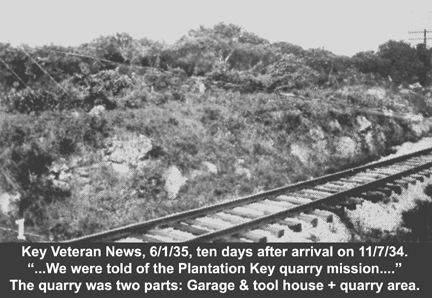 owever, if not for
these I have not found actual photos as I have for post 1935 hurricane
data. owever, if not for
these I have not found actual photos as I have for post 1935 hurricane
data.
From
page 5 of the Key Veteran News, page 5, we read: "Ten days after
our
arrival in camp, we were told that our main work-project would be
the quarrying of rock for the overseas
bridges to Key West." This
was the text for the number 1 photo one of a collage of eight
photos. The "we" of this text were the 350 veterans
under Capt.
Robertson arriving at Windley Keys on November 6, 1934. A contingent
of 50 men had preceded this group to prepare a dining room and kitchen.
This was not
actually an article, but a 11 x 11 3/4 inch collage of eight photos of
unknown origin
with numbers imprinted on each photo (At the lower-left of this photo)
with a narrative description
below. The above quotation is the description of photo one. T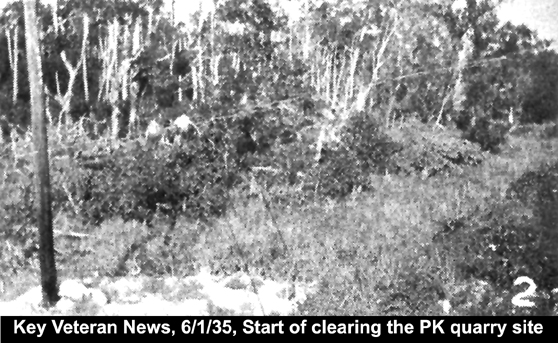 oday
this area would be at about MM 86 bayside just across from the FDOT
weigh station. There are building now built on the site, but was vacant
in 1991 when Bernard Russell of Islamorada showed it to me. The area
appears more or less level now (not a hole) but was
quite elevated before the quarrying.
Photo 2 shows the beginning of clearing for the actual quarry
site. Quoting "That land was covered by mahogany and
various other trees and very thick undergrowth." I assume this clearing
is being done by the some of the new 350 vets. oday
this area would be at about MM 86 bayside just across from the FDOT
weigh station. There are building now built on the site, but was vacant
in 1991 when Bernard Russell of Islamorada showed it to me. The area
appears more or less level now (not a hole) but was
quite elevated before the quarrying.
Photo 2 shows the beginning of clearing for the actual quarry
site. Quoting "That land was covered by mahogany and
various other trees and very thick undergrowth." I assume this clearing
is being done by the some of the new 350 vets.
-
-
Photo 3 shows the clearing of the vehicle garage,
gasoline dispensers and
tool
buildings. This part of the quarry is between the railroad and the
highway, where the quarry itself is west of both of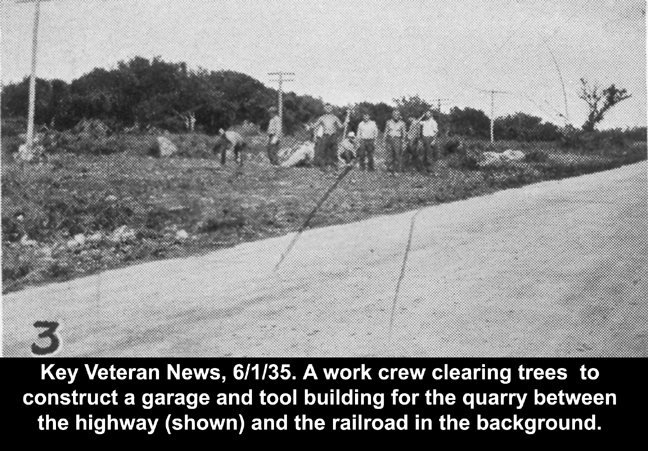 those. The railroad is below the line of sight and parallel with the
telephone/telegraph poles. We will see the actual building in photo 4.
those. The railroad is below the line of sight and parallel with the
telephone/telegraph poles. We will see the actual building in photo 4.
-
-
-
-
-
-
-
-
-
Photo 4 scanned very poorly so I
substituted a regular photo showing the present
quarry area, present being June 1935. The description s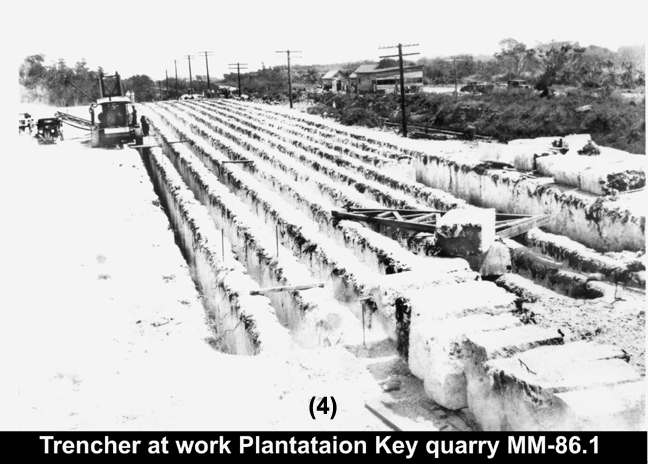 tates:
"...where
the boys received their first instruction in sawing stones to
measurements for a Roman arch bridge. Their sawing was done by common
wood cross-cut saws through blocks of stone measuring 30 inches wide by
4
feet long and 8 feet deep [This is the finished size - JW], the first
operation of its kind known in
quarry annals. The men quickly mastered the art of push and pull and
each became an expert stone sawyer. The original photo did not show
this description and the one I substituted at least shows the trencher
at work and the garage and tool buildings in the background. The trench
or ditch cuts were 30 inches wide and 8 feet deep. A second pass with
trencher was made perpendicular to the above rows to appear as a
checkerboard pattern. Another photo is below photo 4 to further clarify
this procedure. The vertical slabs were then scored and br tates:
"...where
the boys received their first instruction in sawing stones to
measurements for a Roman arch bridge. Their sawing was done by common
wood cross-cut saws through blocks of stone measuring 30 inches wide by
4
feet long and 8 feet deep [This is the finished size - JW], the first
operation of its kind known in
quarry annals. The men quickly mastered the art of push and pull and
each became an expert stone sawyer. The original photo did not show
this description and the one I substituted at least shows the trencher
at work and the garage and tool buildings in the background. The trench
or ditch cuts were 30 inches wide and 8 feet deep. A second pass with
trencher was made perpendicular to the above rows to appear as a
checkerboard pattern. Another photo is below photo 4 to further clarify
this procedure. The vertical slabs were then scored and br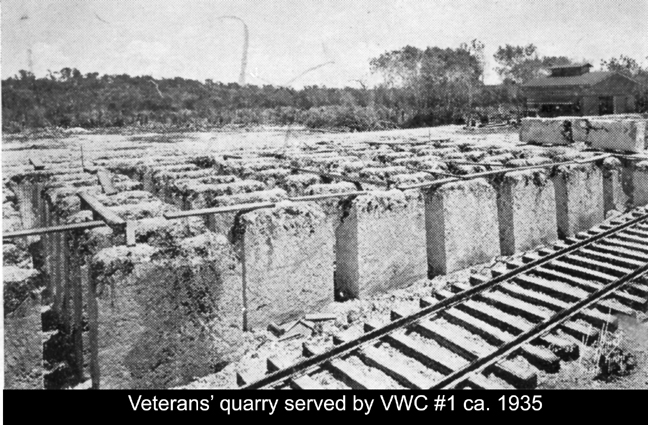 oken
loose at the bottoms to form the rough finished product to be
transported to the finishing yard for hand sawing
into the prescribed sizes. A gin-pole stiff legged derrick off
camera manipulated the slabs after cutting. As of May 4, 1935, about
88,000 cubic feet had been sawed. Two men averaged 82 cubic feet
per day. The
remainder of the photos all show groups
of men sawing the coral blocks.
The resolution is poor but the railroad
is much lower in elevation than
the surrounding areas. oken
loose at the bottoms to form the rough finished product to be
transported to the finishing yard for hand sawing
into the prescribed sizes. A gin-pole stiff legged derrick off
camera manipulated the slabs after cutting. As of May 4, 1935, about
88,000 cubic feet had been sawed. Two men averaged 82 cubic feet
per day. The
remainder of the photos all show groups
of men sawing the coral blocks.
The resolution is poor but the railroad
is much lower in elevation than
the surrounding areas.
-
-
-
Photo 5 is of a group at the sawing benches.
There are two men standing o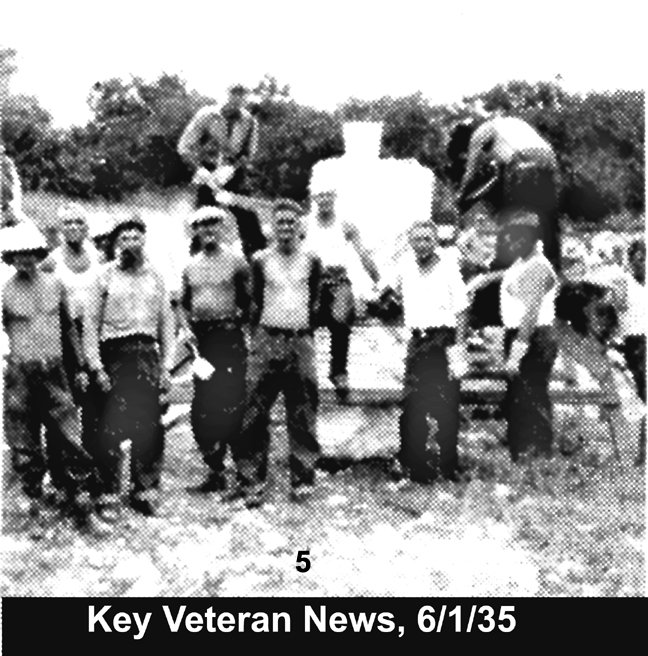 n
top of the bench sawing one of the 8 foot slabs. Each finished slab weighed about five tons.
The cross-cut saws were
actually specially tempered 5-foot two-man saws. The first hand
cut blocks were cut on December 12, 1934. They are about ready
to remove the bench so they can saw lower eventually separating the
side pieces. The
description is as follows: "In Picture 5 are: Roy, Diamond, Midrick,
Cook, Pawa, Allman, Rooney, O'Donnell, Connolly, Kirby, Scott,
Cunningham, and Thompson." n
top of the bench sawing one of the 8 foot slabs. Each finished slab weighed about five tons.
The cross-cut saws were
actually specially tempered 5-foot two-man saws. The first hand
cut blocks were cut on December 12, 1934. They are about ready
to remove the bench so they can saw lower eventually separating the
side pieces. The
description is as follows: "In Picture 5 are: Roy, Diamond, Midrick,
Cook, Pawa, Allman, Rooney, O'Donnell, Connolly, Kirby, Scott,
Cunningham, and Thompson."
Unfortunately the images are poor, but
we can at least give names of the veterans. I will use spaces to
facilitate alignment of the photos.
There are 8 photos in this series and
then a series of unidentified even poorer quality images.
-
-
-
-
Photo 6 is another group
photo showing the work bench better. The description
is" Picture 6 are shown: Nabal, Martin,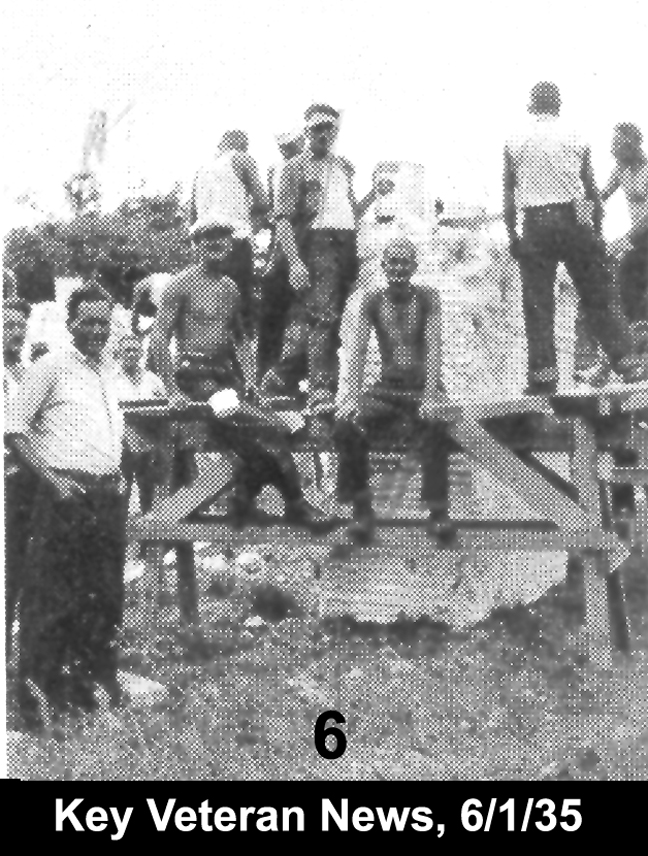 Rooney, Pawa, Stypczynski, Oswald, Neary, Allman, Weir and
Nabal.
Rooney, Pawa, Stypczynski, Oswald, Neary, Allman, Weir and
Nabal.
The sawyers worked in
relief teams and swapped turns as appropriate to the weather and
conditions of the men. Some teams sawed faster than others and in time
would pair up as appropriate.
-
-
-
-
-
-
-
-
-
-
-
-
-
-
-
Photo 7 is another group of
working veterans and the description is: "In Picture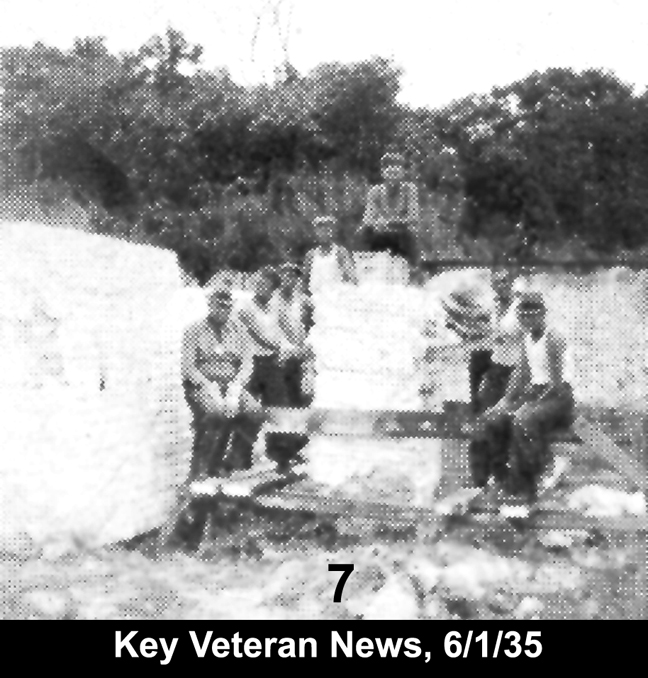 e 7
are: Cunningham, Morley, Ericson, Sims, Huggins, Gaudet. Oswald, Neary,
Allman, and Scott." e 7
are: Cunningham, Morley, Ericson, Sims, Huggins, Gaudet. Oswald, Neary,
Allman, and Scott."
The rough cut blocks were not always moved out of
the solaced pit
-
-
-
-
-
-
-
-
-
-
-
-
-
-
-
Photo 8 is another group of
workers with their work benches, blocks of coral and the description
is: "In Picture 8 we see: Scott, Stypczy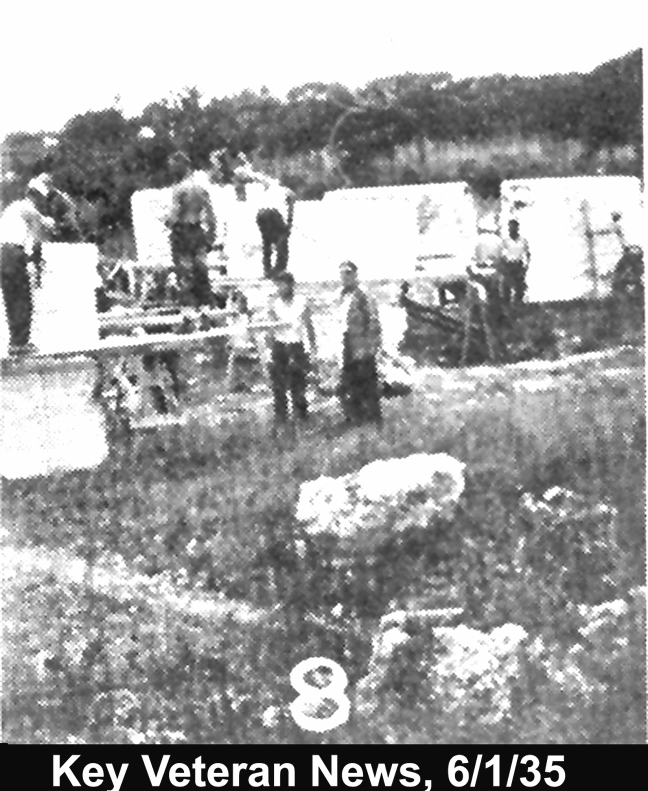 nski,
Johnson, Nye, McCarthy,
Thompson, Neary, Ulrich, Martin and Nabal." nski,
Johnson, Nye, McCarthy,
Thompson, Neary, Ulrich, Martin and Nabal."
Under the description reads:
"The mosquito being out of season in those days, some of the men are
shown stripped to the waist and exposed to the helpful elements of
sunniest Florida. From this we learn that these photos were taken
before June 1, 1935.
The stone cutting was done
under the able direction of Henry Freeman, superintendent of the
quarry, Leader E. J. Martin and Assistant Leaders Nabal and Neary."
From Plantation Key the finished blocks of coral, known today as
'Keystone' were transported to Camp 3 docks at southern Lower Matecumbe
Key and relayed out to the prepared bridge pier coffer dams (forms) and
lowered in with concrete poured totally enclosing each
block. Henry Flagler used all concrete for his bridge piers, but
evidently for vehicles this would suffice. I have never located any
specifications, drawings, etc. for this project. At about MM 73. 3,
depending on visibility because of vegetation, etc., three finished
piers and 5 partially completed piers are visible today. These piers
and the small island between the piers and Lower Matecumbe Key are all
that remain of actual work performed by the WW-I Veterans.
Below are five miscellaneous
images which I have with no descriptions, but obviously of the
Veterans' camp 1 and the quarry. The images were all on one sheet of
white paper.
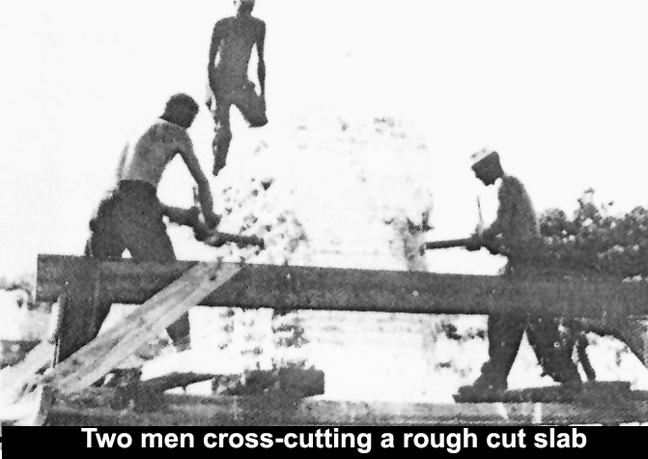 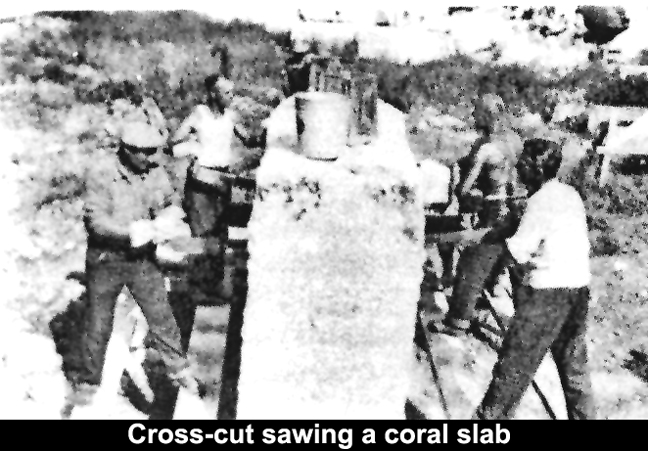
-
-
-
-
-
-
-
-
-
-
-
-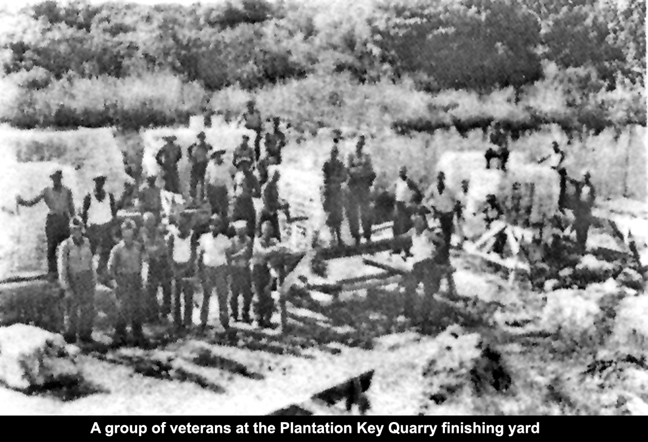 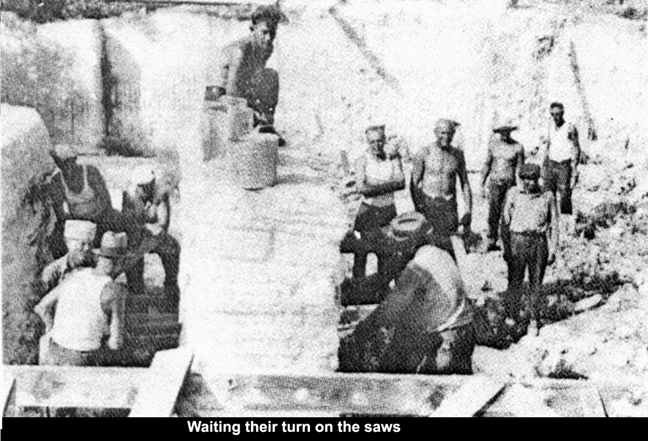
-
-
-
-
-
-
-
-
-
-
-
-
-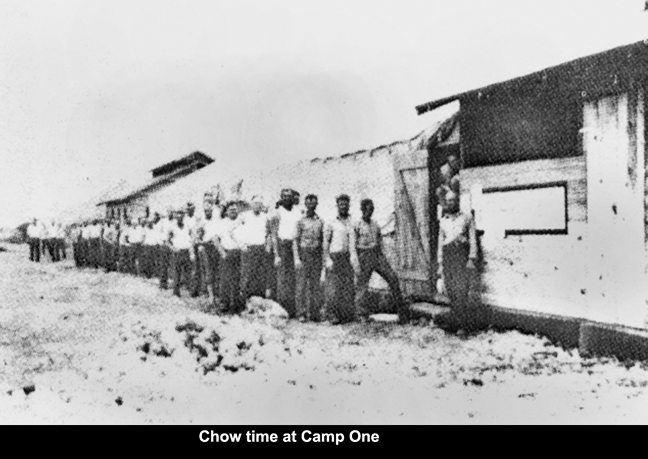
-
-
|
